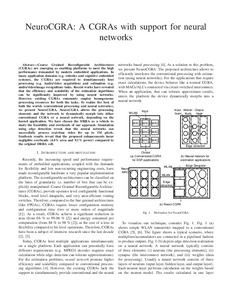NeuroCGRA: A CGRA with support for neural networks
Ahmed Hemani; Juha Plosila; Syed M. A. H. Jafri; Tuan Nguyen; Masoud Daneshtalab; Sergei Dytckov; Hannu Tenhunen
NeuroCGRA: A CGRA with support for neural networks
Ahmed Hemani
Juha Plosila
Syed M. A. H. Jafri
Tuan Nguyen
Masoud Daneshtalab
Sergei Dytckov
Hannu Tenhunen
Julkaisun pysyvä osoite on:
https://urn.fi/URN:NBN:fi-fe2021042715038
Coarse Grained Reconfigurable Architectures
(CGRAs) are emerging as enabling platforms to meet the high
performance demanded by modern embedded applications. In
many application domains (e.g. robotics and cognitive embedded
systems), the CGRAs are required to simultaneously host
processing (e.g. Audio/video acquisition) and estimation (e.g.
audio/video/image recognition) tasks. Recent works have revealed
that the efficiency and scalability of the estimation algorithms
can be significantly improved by using neural networks.
However, existing CGRAs commonly employ homogeneous
processing resources for both the tasks. To realize the best of
both the worlds (conventional processing and neural networks),
we present NeuroCGRA. NeuroCGRA allows the processing
elements and the network to dynamically morph into either
conventional CGRA or a neural network, depending on the
hosted application. We have chosen the DRRA as a vehicle to
study the feasibility and overheads of our approach. Simulation
using edge detection reveal that the neural networks can
successfully process real-time video for up to 1M pixels.
Synthesis results reveal that the proposed enhancements incur
negligible overheads (4.4% area and 9.1% power) compared to
the original DRRA cell.
https://urn.fi/URN:NBN:fi-fe2021042715038
Tiivistelmä
Coarse Grained Reconfigurable Architectures
(CGRAs) are emerging as enabling platforms to meet the high
performance demanded by modern embedded applications. In
many application domains (e.g. robotics and cognitive embedded
systems), the CGRAs are required to simultaneously host
processing (e.g. Audio/video acquisition) and estimation (e.g.
audio/video/image recognition) tasks. Recent works have revealed
that the efficiency and scalability of the estimation algorithms
can be significantly improved by using neural networks.
However, existing CGRAs commonly employ homogeneous
processing resources for both the tasks. To realize the best of
both the worlds (conventional processing and neural networks),
we present NeuroCGRA. NeuroCGRA allows the processing
elements and the network to dynamically morph into either
conventional CGRA or a neural network, depending on the
hosted application. We have chosen the DRRA as a vehicle to
study the feasibility and overheads of our approach. Simulation
using edge detection reveal that the neural networks can
successfully process real-time video for up to 1M pixels.
Synthesis results reveal that the proposed enhancements incur
negligible overheads (4.4% area and 9.1% power) compared to
the original DRRA cell.
Kokoelmat
- Rinnakkaistallenteet [19207]
